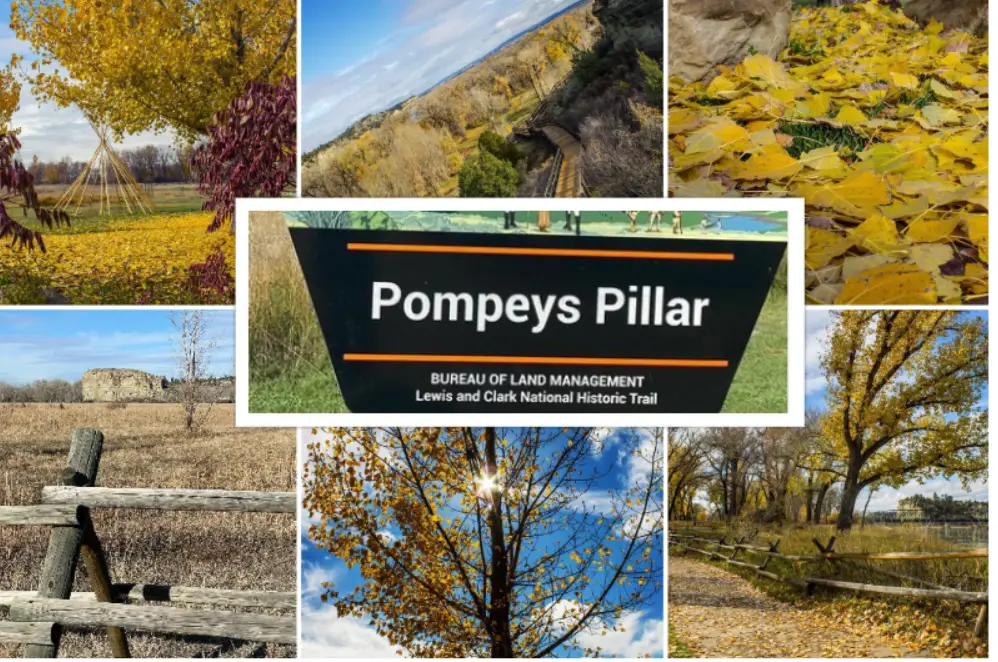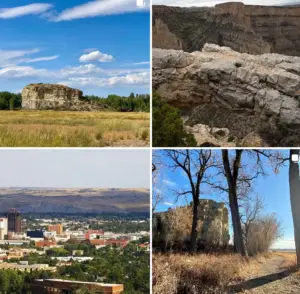Pompeys Pillar National Monument : Interesting Facts, History & Travel Guide

- By
- Aparna Patel
- |
- 13 Apr, 2023
- |

Pompeys Pillar National Monument is a fascinating destination located in south-central Montana, rich in natural beauty and American history. The centerpiece of the monument is Pompeys Pillar, a towering sandstone rock formation that rises 150 feet above the Yellowstone River.
This unique landmark played a significant role in the Lewis and Clark Expedition, with William Clark carving his name into the rock during his exploration of the area in 1806. In this guide, we’ll delve into the rich history and significance of Pompeys Pillar, as well as provide practical travel information for visitors who want to explore the area.
From hiking trails to scenic drives, we’ll cover all the best ways to experience the natural beauty and historical significance of Pompeys Pillar National Monument. Whether you’re a history buff, a nature lover, or simply looking for a unique and memorable travel destination, Pompeys Pillar is definitely worth a visit.
Table of Contents
Interesting facts about Pompeys Pillar National Monument
- Pompeys Pillar is a sandstone rock formation that rises 150 feet above the Yellowstone River. It is believed to be over 80 million years old.
- The name “Pompeys Pillar” comes from the nickname given to the formation by William Clark, of the famous Lewis and Clark Expedition. Clark named the rock after Sacagawea’s son, Jean Baptiste Charbonneau, who was nicknamed “Pompy.”
- The monument is home to the only remaining physical evidence of the Lewis and Clark Expedition. William Clark carved his signature and the date into the rock on July 25, 1806, during the expedition’s return journey.
- The monument covers an area of 51 acres and includes a visitor center, picnic areas, and a walking trail.
- The site was designated a National Monument in 2001 by President Bill Clinton.
- Pompeys Pillar is a sacred site to many Native American tribes, who have lived in the area for thousands of years. The monument is an important cultural and spiritual site for these tribes.
- The monument is home to a diverse range of plant and animal species, including bighorn sheep, pronghorn antelope, and mule deer.
- The monument hosts several events and programs throughout the year, including guided tours, educational programs, and cultural events.
- Visitors can climb to the top of Pompeys Pillar for a panoramic view of the surrounding landscape.
- A visit to Pompeys Pillar National Monument is a unique and educational experience that offers a glimpse into the rich history and culture of the area.
Read More:
- Pipe Spring National Monument : Interesting Facts, History & Travel Guide
- Petroglyph National Monument : Interesting Facts, History & Travel Guide
- Organ Pipe Cactus National Monument : Interesting Facts, History & Travel Guide
Information & History of Pompeys Pillar National Monument
Pompeys Pillar National Monument is a sandstone rock formation located in south-central Montana, in the United States. The monument covers an area of 51 acres and includes a visitor center, picnic areas, and a walking trail. Here is a brief history of the site:
Native American Presence:
The area around Pompeys Pillar has been inhabited by various Native American tribes for thousands of years, including the Crow and Cheyenne tribes. The site is considered a sacred place by these tribes, and the rock formation is an important cultural and spiritual site.
Lewis and Clark Expedition:
Pompeys Pillar gained national attention in 1806 when William Clark of the famous Lewis and Clark Expedition arrived at the site during the expedition’s return journey. Clark named the rock formation “Pompeys Tower” after Sacagawea’s son, Jean Baptiste Charbonneau, who was nicknamed “Pompy.” Clark carved his signature and the date, July 25, 1806, into the rock, making it the only remaining physical evidence of the expedition.
Settlement and Development:
In the late 1800s, the area around Pompeys Pillar began to be settled by ranchers and farmers. The Northern Pacific Railway also passed through the area, bringing increased development and traffic to the region. In 1939, the U.S. Bureau of Land Management acquired the land around Pompeys Pillar and designated it a National Historic Landmark.
National Monument Designation:
In 2001, President Bill Clinton signed a bill designating Pompeys Pillar a National Monument, officially recognizing its historic and cultural significance. Today, the monument is managed by the Bureau of Land Management and offers visitors the opportunity to learn about the site’s rich history and explore the surrounding landscape.
Travel Guide for Pompeys Pillar National Monument
Getting There:
The nearest major city to Pompeys Pillar National Monument is Billings, Montana, which is about 30 miles west of the site. The monument can be accessed by car via Interstate 94, which runs through the area. There is also a small airport located in Billings for those who prefer to fly.
Things to Do:
- Visit the Visitor Center: The visitor center offers exhibits and information about the history and cultural significance of the site. There is also a gift shop selling souvenirs and books.
- View William Clark’s Signature: The main attraction at Pompeys Pillar is William Clark’s signature and the date, which he carved into the rock on July 25, 1806, during the Lewis and Clark Expedition. Visitors can climb to the top of the rock formation for a closer view of the signature and a panoramic view of the surrounding landscape.
- Take a Walk: The monument has a walking trail that leads visitors through the surrounding landscape, providing an opportunity to see local wildlife and learn about the area’s natural history.
- Attend Special Events: The monument hosts several events and programs throughout the year, including guided tours, educational programs, and cultural events.
Tips for Visiting:
- Wear Comfortable Shoes: The walking trail at Pompeys Pillar can be steep in places and is not paved, so it’s recommended to wear comfortable shoes for walking.
- Bring Sun Protection: Montana’s high elevation and strong sunlight can make for a hot and sunny experience, so be sure to bring sunscreen, a hat, and sunglasses.
- Follow Park Rules: To preserve the monument and ensure the safety of visitors, there are specific rules in place at Pompeys Pillar, including no climbing on the rock formation and no pets allowed on the trail.
A visit to Pompeys Pillar National Monument is a unique and educational experience that offers a glimpse into the rich history and culture of the area. With its stunning rock formation and unique historical significance, it’s a must-visit destination for any traveler to Montana.
More Post
- Mount St. Helens Volcanic : Interesting Facts, History & Travel Guide
- Montezuma Castle National Monument : Interesting Facts, History & Travel Guide
- Mojave Trails National Monument : Interesting Facts, History & Travel Guide
- Misty Fjords National Monument : Interesting Facts, History & Travel Guide
Frequently asked questions about Pompeys Pillar National Monument:
What is the history of Pompeys Pillar?
The area around Pompeys Pillar has been inhabited by various Native American tribes for thousands of years, and the rock formation is considered a sacred place by these tribes. It gained national attention in 1806 when William Clark of the Lewis and Clark Expedition carved his signature into the rock. The site was later settled by ranchers and farmers in the late 1800s, and in 1939, it was designated a National Historic Landmark. It was later designated a National Monument in 2001.
How do I get to Pompeys Pillar?
The nearest major city to Pompeys Pillar National Monument is Billings, Montana, which is about 30 miles west of the site. The monument can be accessed by car via Interstate 94, which runs through the area.
What is there to do at Pompeys Pillar National Monument?
Visitors can view William Clark’s signature and the date, climb to the top of the rock formation for a panoramic view of the surrounding landscape, and explore the walking trail that leads through the surrounding landscape. The visitor center offers exhibits and information about the history and cultural significance of the site.
What is the admission fee for Pompeys Pillar National Monument?
The admission fee for Pompeys Pillar National Monument is $7 per person for those over 16 years old. Admission is free for children under 16.
Are pets allowed at Pompeys Pillar National Monument?
No, pets are not allowed on the walking trail at Pompeys Pillar National Monument in order to protect the natural environment and preserve the site’s cultural significance.
What are some nearby attractions to Pompeys Pillar National Monument?
Some nearby attractions include the Little Bighorn Battlefield National Monument, the Yellowstone River, and the Pictograph Cave State Park.
Search Posts
Latest posts
-
4 Mar, 2024
Why would you wrap your luggage in plastic?
-
4 Mar, 2024
How to make dining alone less awkward?
-
4 Mar, 2024
Why are there no seat belts on trains?
Popular posts
-
5 Mar, 2024
Why prohibit engine braking?
